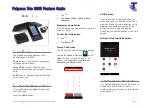
DSP Resources
DSP cards provide digital signal processor (DSP) resources, and the PBX uses the resources to perform
various PBX operations. The following illustration shows the concept of DSP resource usage. More complex
situations may require additional resources, and in some cases the amount of DSP resources required may
be less than expected.
Conference
0.5
Outgoing Message
(DISA)
2
1
Music on Hold (MOH)/
External Paging (EPG)
1
Internal MOH
Unified Messaging
1.3
PBX
Doorphone
3
1
Analogue
Trunk
*1
2.2
G.729A
G.711
1
IP Trunk
*1
2.2
G.729A
G.711
1
IP-PT
1
SLT
1
BRI
*1
1
PRI
*1
: Required DSP Resources
UM Tone Generator
2
Echo Canceller
3
2.2
G.729A
G.711
1
IP-CS
PS
DPT
*1
1
*1
Connections that arrive over a stacking connection require the same amount of DSP resources as shown in this example.
Note
This is an example for a stand-alone KX-NS1000.
Required DSP Resources Assessment
The maximum number of simultaneous calls, operations and features using IP protocols is determined by the
DSP card installed in the PBX. According to the number of resources required, you can install up to 2 DSP
cards.
To decide how much resources are required for the PBX, the DSP Resource Advisor can be useful.
Installation Manual
67
2.3.3 System Capacity
Summary of Contents for KX-NS1000
Page 40: ...40 Installation Manual 1 4 Data Security ...
Page 76: ...76 Installation Manual 2 3 3 System Capacity ...
Page 108: ...108 Installation Manual 3 1 3 Using CTI Applications ...
Page 267: ...the priority Installation Manual 267 5 8 3 Setting LLDP Parameters ...
Page 312: ...312 Installation Manual 5 12 Automatic Configuration of Mailboxes ...
Page 318: ...318 Installation Manual 6 2 Methods of Stacking PBXs ...
Page 332: ...332 Installation Manual 7 1 6 Troubleshooting by Error Log ...
Page 400: ...400 Installation Manual 8 6 26 WAN Port Mirroring ...
Page 414: ...414 Installation Manual 9 3 7 PCMPR Software File Version 004 1xxxx ...
















































